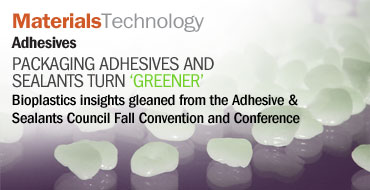
by Jeff Timm, Managing Principal, Timm Consulting
To see this article in digital form, Click Here and see page 26.The Adhesive & Sealant Council (ASC,www.ascouncil.org) held its annual Fall Conference and Convention Oct 17-18 in Indianapolis, IN. It was a good chance to check the pulse of the state of bioplastics in this industry.
The largest segment for adhesive usage by volume is packaging and that segment is even larger when packaging tapes and labels incorporating pressure-sensitive adhesives (PSA) are added. The adhesive industry usually reports tapes and labels as a separate end-use segment.
For years the industry has promoted water-based adhesive (acrylic, urethane, etc.) alternatives to solvent-based adhesives as the answer to environmental concerns related to volatile organic components (VOCs). Now the realization that “it’s the % solids stupid” is taking hold. Although the adhesives and sealants industry is not as far along the sustainability learning curve when comparing it to the packaging industry as a whole, it is clearly aware of the need to consider and implement sustainability solutions. An example of this renewed awareness is the first industry-sponsored ASC Sustainability Conference held this past July.
An oft- heard phrase is “adhesives are the last thing considered when designing a package and are used in such small per-package quantities that they are often ignored.” This position is changing. The new awareness is being driven by the same drivers that affect packaging overall. They include Wal-Mart and other retailers subscribing to a sustainability agenda, brand owners demanding their value chain partners supply them with sustainable raw material offerings and the consumer demanding less packaging materials being used, more and clearer options regarding end-of-life alternatives, pricing parity and products that are safe.
Discussions and presentations at the Fall Conference focused on addressing some of these issues:
• New focus on recycle contamination: Wal-Mart and adhesive companies are supporting the Association of Postconsumer Plastic Recyclers (APR,www.plasticsrecycling.org) protocol for evaluating labels and adhesives used on thermoformed polyethylene terephthalate (PET) containers and their compatibility with PET recycling. This protocol encourages the design of packaging for greater recyclability and improves the quality of post-consumer PET entering the recycle system.
Although not discussed at the conference, adhesive-based recycle contamination is a broader problem than just PET thermoformed containers. It is present in the recycle of PET bottles, high-density polyethylene (HDPE) bottles, multilayer film laminations, coextruded tie layers and laminating adhesives and paper products (corrugated) with the ever-present adhesive-caused “stickies.”
• Renewable hot-melt adhesives: DaniMer Scientific (www.danimer.com), took the opportunity at the Conference to provide detail on their biomass-sourced, renewable hot-melt adhesive (RHMA). Four to five bioplastic grades will be offered for such end-use applications as case and carton sealing, paper cup assembly and even a hot melt PSA for labels. The specific technology was still not totally revealed; however, ample pilot plant quantities exist for development. Sijo Global Partners (SijoGP) will provide distribution for DaniMer’s RHMA. The new DaniMer RHMA provides for multiple end-of-life options including hydro repulping, recycling and composting (meeting the ASTM 6400 standard).
• Absence of bio-based renewable polymer chemistries: As a presenter, I discussed the multitude of new bio-based renewable polymer chemistries that are being introduced as replacement technologies for petroleum-based materials in other end-use plastic markets like rigid and film packaging applications, automotive, consumer and durable products. The staggering flurry of global renewable activity present in the olefin, nylon, polyurethane, acrylic and styrenic products, all bases for compounded adhesive technologies, has not seemed to have entered adhesive markets as yet.
A need for proactive vendors
Part of the reason for this is the relatively small polymer volumes most adhesive applications provide as opportunity for adhesive raw material suppliers. When polymer companies look at their opportunity hierarchy, adhesives often do not make the “new product development” cut. Adhesive companies will have to be more aggressive with their suppliers by demanding development opportunities so they can cash in on sustainability solutions that renewable bio-based plastics can provide.
Jeff Timm has spent more than 35 years in the plastics industry with Fortune 100 companies. The last six years have been as managing principal for Timm Consulting, Franksville, WI, a plastics business and market development consultancy focusing on bioplastics. He can be reached at jeff@timmconsulting.net or at 262-880-7353.
A renewable adhesive for cartons and cases
Another new adhesive that brings more sustainability into the market was found at Pack Expo Las Vegas in the booth of A-B-C Packaging Machinery (www.abcpackaging.com) on its Model 450 all-mechanical bottom case sealer. A-B-C was the only PELV OEM that demonstrated H.B. Fuller’s (www.hbfuller.com) new Liquamelt® adhesive. Made from 40% biorenewable ingredients, Liquamelt is a low-density, soy-based adhesive that flows at room temperature, heats up at time of adhesion and sets rapidly. It forms strong bonds on a wide variety of substrates including cases and cartons. Liquamelt is a sustainable, cost-saving material that allows for more than 50% reduction in adhesive usage, H.B. Fuller claims.
John Channon, H.B. Fuller business director, packaging adhesives, believes this presents the first new method to sealing cases and cartons in 50 years. “Packagers large and small are looking for ways to improve the sustainability impact of the products that they offer to their customers, so the interest level in adhesives that contribute in this manner is very high,” he says. “In addition, some of the ‘greener’ benefits of the Liquamelt system such as significantly lower energy usage and lower maintenance translate into cost savings that customers welcome.”
The Liquamelt system from Graco (www.graco.com) pumps a 99% solids liquid through regular, unheated hydraulic hoses to a patented TurboActivator™ that is positioned just before dispensing heads. Here the liquid is heat activated and then dispensed as hot foam; the foaming quality helps to add “mileage” to the product.
The Liquamelt system can be adapted to existing packaging machinery and integrated into a customer’s standard hot melt dispensing technology.
-Rick Lingle, Editor in Chief
